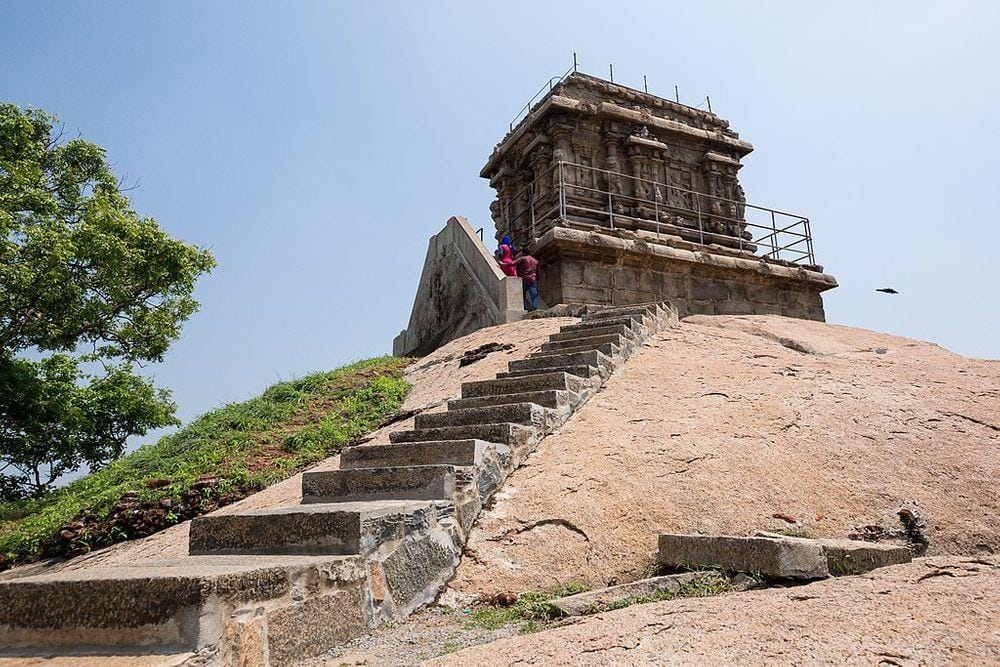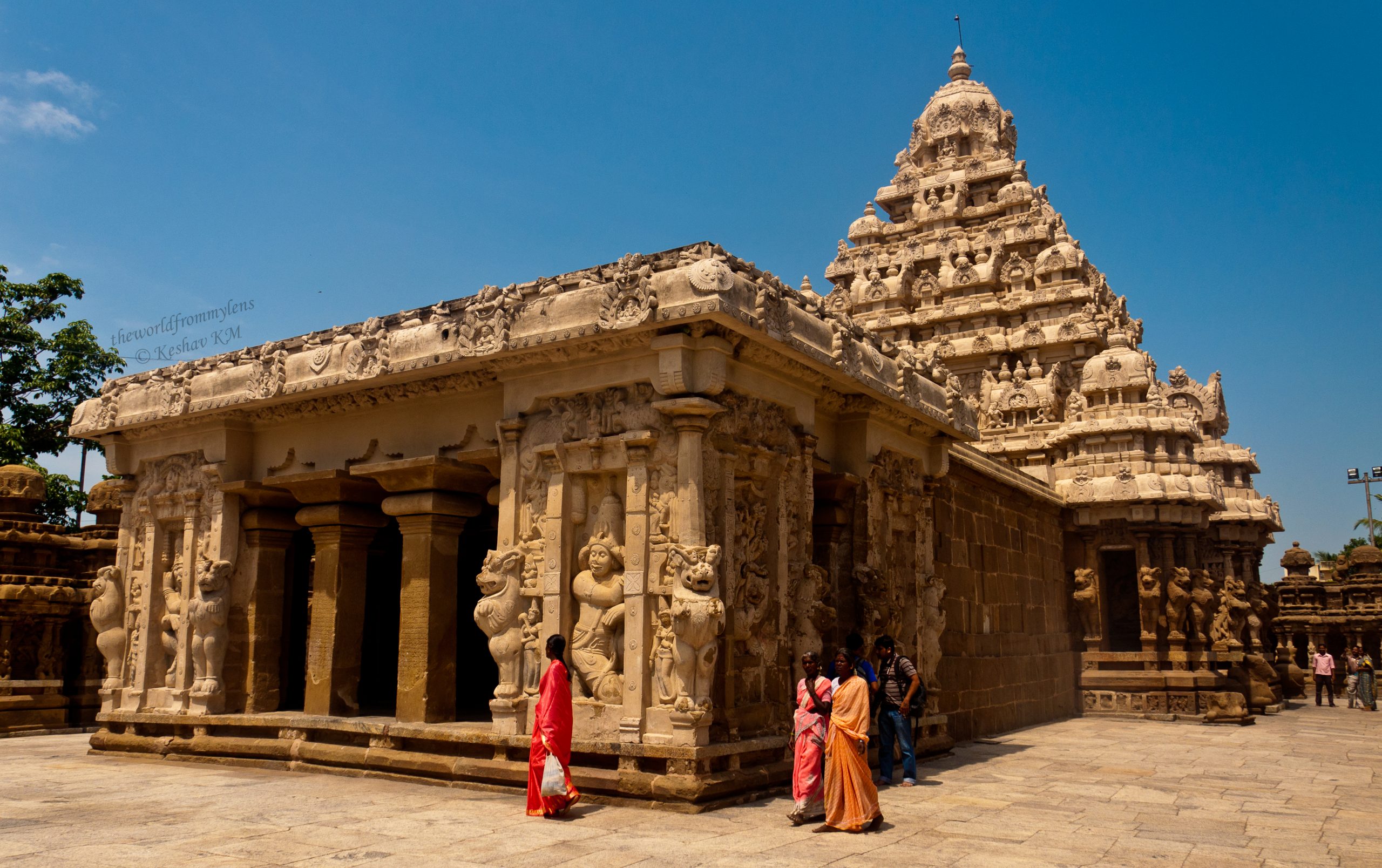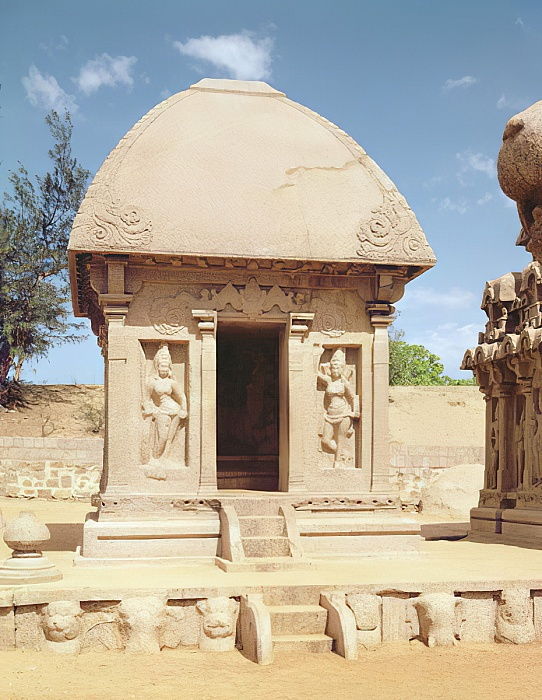The Dec 31st Static Quiz on Art and Culture (Pallavas and Post Gupta)
Quiz-summary
0 of 10 questions completed
Questions:
- 1
- 2
- 3
- 4
- 5
- 6
- 7
- 8
- 9
- 10
Information
The Dec 31st Static Quiz on Art and Culture (Pallavas and Post Gupta)
You have already completed the quiz before. Hence you can not start it again.
Quiz is loading...
You must sign in or sign up to start the quiz.
You have to finish following quiz, to start this quiz:
Results
0 of 10 questions answered correctly
Your time:
Time has elapsed
You have reached 0 of 0 points, (0)
Categories
- Not categorized 0%
- 1
- 2
- 3
- 4
- 5
- 6
- 7
- 8
- 9
- 10
- Answered
- Review
- Question 1 of 10
1. Question
Which of the followings art and architecture belong to Pallavas?
1. The Shore Temple
2. The Arjuna Penance
3. Olakkannesvara TempleCorrectAns;- d) All of the above
Explanation;-
• All the 3 belongs to Pallava dynasty.
• The Olakkannesvara Temple is in Mahabalipuram town, overlooking the Coromandel Coast of the Bay of Bengal in Kancheepuram District in Tamil Nadu, India. Like the Shore Temple, the Olakkannesvara Temple is a structural temple.
• Descent of the Ganges is a monument at Mamallapuram, on the Coromandel Coast of the Bay of Bengal, in the Chengalpattu district of the state of Tamil Nadu, India. Measuring 96 by 43 feet, it is a giant open-air rock relief carved on two monolithic rock boulders.

• The Shore Temple is so named because it overlooks the shore of the Bay of Bengal. It is located near Chennai in Tamil Nadu. It is a structural temple, built with blocks of granite, dating from the 8th century AD.
 Incorrect
IncorrectAns;- d) All of the above
Explanation;-
• All the 3 belongs to Pallava dynasty.
• The Olakkannesvara Temple is in Mahabalipuram town, overlooking the Coromandel Coast of the Bay of Bengal in Kancheepuram District in Tamil Nadu, India. Like the Shore Temple, the Olakkannesvara Temple is a structural temple.
• Descent of the Ganges is a monument at Mamallapuram, on the Coromandel Coast of the Bay of Bengal, in the Chengalpattu district of the state of Tamil Nadu, India. Measuring 96 by 43 feet, it is a giant open-air rock relief carved on two monolithic rock boulders.

• The Shore Temple is so named because it overlooks the shore of the Bay of Bengal. It is located near Chennai in Tamil Nadu. It is a structural temple, built with blocks of granite, dating from the 8th century AD.

- Question 2 of 10
2. Question
Which of the following literary work’s by Banabhatta?
1. Harsha Charita
2. Kadambari
3. MahaviracharitaCorrectAns;- a) Only 1 and 2
Explanation;-
• The 1st and 2nd work by Banabhatta, 3rd work by Bhavabhuti, that’s y answer is A.
• The detailed about the works shown in the below table. Incorrect
IncorrectAns;- a) Only 1 and 2
Explanation;-
• The 1st and 2nd work by Banabhatta, 3rd work by Bhavabhuti, that’s y answer is A.
• The detailed about the works shown in the below table.
- Question 3 of 10
3. Question
Which one of the following common element between the Kailasanatha Temple at Ellora and Shore Temple at Mamallapuram?
CorrectAns;- c) Both are belongs to Gupta Period
Explanation;-
• Kailasanatha temple at Ellora and the Shore Temple at Mamallapuram were built around the same time both are Gupta Period.
• The Kanchi Kailasanatha temple is the oldest structure in Kanchipuram. Located in Tamil Nadu, India, it is a Hindu temple in the Tamil architectural style.
• It is dedicated to the Lord Shiva, and is known for its historical importance.
• The temple was built from 685-705 AD by a Rajasimha ruler of the Pallava Dynasty.
• The Shore Temple is so named because it overlooks the shore of the Bay of Bengal. It is located near Chennai in Tamil Nadu. It is a structural temple, built with blocks of granite, dating from the 8th century AD.
IncorrectAns;- c) Both are belongs to Gupta Period
Explanation;-
• Kailasanatha temple at Ellora and the Shore Temple at Mamallapuram were built around the same time both are Gupta Period.
• The Kanchi Kailasanatha temple is the oldest structure in Kanchipuram. Located in Tamil Nadu, India, it is a Hindu temple in the Tamil architectural style.
• It is dedicated to the Lord Shiva, and is known for its historical importance.
• The temple was built from 685-705 AD by a Rajasimha ruler of the Pallava Dynasty.
• The Shore Temple is so named because it overlooks the shore of the Bay of Bengal. It is located near Chennai in Tamil Nadu. It is a structural temple, built with blocks of granite, dating from the 8th century AD.
- Question 4 of 10
4. Question
Which of the following statements regarding Harshavardhana art and architecture are incorrect?
1. Harshvardhana’s realm is associated with construction of numerous stupas and monasteries.
2. Harsha patronized the Nalanda University by his liberal endowments.CorrectAns;- d) None of the above
Explanation;-
• As question asked to choose incorrect statement but both the statements are correct.
• The art and architectural contributions of Harsha’s period are very few and mostly followed the Guptas.
• Harshvardhana’s realm is associated with construction of numerous stupas and monasteries.
• Harsha patronized the Nalanda University by his liberal endowments.
• The brick temple of Lakshmana at Sirpur with its rich architecture is assigned to the period of Harsha.IncorrectAns;- d) None of the above
Explanation;-
• As question asked to choose incorrect statement but both the statements are correct.
• The art and architectural contributions of Harsha’s period are very few and mostly followed the Guptas.
• Harshvardhana’s realm is associated with construction of numerous stupas and monasteries.
• Harsha patronized the Nalanda University by his liberal endowments.
• The brick temple of Lakshmana at Sirpur with its rich architecture is assigned to the period of Harsha. - Question 5 of 10
5. Question
Which of the following are the author of “Aihole Prasasti”?
CorrectAns;- c) Ravikirti
Explanation;-
 Incorrect
IncorrectAns;- c) Ravikirti
Explanation;-

- Question 6 of 10
6. Question
Which of the following statements regarding Pallavas Art and Architecture are correct?
1. The Pallava era witnesses a transition from rock-cut to free-standing temples.
2. Mahendravarman was a pioneer in rock-cut architecture.
3. Narasimhaverman II also known as Rajasimha built the Kanchi Kailasanatha Temple during the late 7th century AD.CorrectAns;- d) All of the above
Explanation;-
• All the statements are correct.
• The beautiful and grand Pallava style of architecture can be divided into four phases or styles:
• 1. Mahendra style (600-625 AD)
2. Mammala style (625-674 AD)
3. Rajasimha and Nadivarman style (674-800 AD)
4. Aparajita style (early 9th century)
• The Pallava era witnesses a transition from rock-cut to free-standing temples.
• Mahendravarman was a pioneer in rock-cut architecture.
• Mandagapattu rock-cut temple was the first rock-cut temple built by him.
• Narasimhaverman II also known as Rajasimha built the Kanchi Kailasanatha Temple during the late 7th century AD.IncorrectAns;- d) All of the above
Explanation;-
• All the statements are correct.
• The beautiful and grand Pallava style of architecture can be divided into four phases or styles:
• 1. Mahendra style (600-625 AD)
2. Mammala style (625-674 AD)
3. Rajasimha and Nadivarman style (674-800 AD)
4. Aparajita style (early 9th century)
• The Pallava era witnesses a transition from rock-cut to free-standing temples.
• Mahendravarman was a pioneer in rock-cut architecture.
• Mandagapattu rock-cut temple was the first rock-cut temple built by him.
• Narasimhaverman II also known as Rajasimha built the Kanchi Kailasanatha Temple during the late 7th century AD. - Question 7 of 10
7. Question
Which of the following statements regarding Pallava art and architecture are incorrect?
1. The Pallava dynasty existed between the 3rd and 9th centuries CE, ruling a portion of what is today Andhra Pradesh (early Pallavas) and Tamil Nadu (later Pallavas).
2. The Pallava architecture shows the transition from the rock cut temples to the stone built temples.CorrectAns;- d) None of the above
Explanation;-
• As question asked to choose incorrect statements but both the statements are correct.
• The Pallava dynasty existed between the 3rd and 9th centuries CE, ruling a portion of what is today Andhra Pradesh (early Pallavas) and Tamil Nadu (later Pallavas).
• The Pallava architecture shows the transition from the rock cut temples to the stone built temples.
• The earliest examples of the Pallava art are the rock cut temples of the 7th century AD, while the later examples are of structural temples built in 8th and 9th century.
• The lasting monolithic temples known as rathas and mandapas provide superb skill of sculptors of Pallava period.
• The monolithic temples (Eg: Five rathas) gave way to structural temples like the Shore temple in Mammalapuram.IncorrectAns;- d) None of the above
Explanation;-
• As question asked to choose incorrect statements but both the statements are correct.
• The Pallava dynasty existed between the 3rd and 9th centuries CE, ruling a portion of what is today Andhra Pradesh (early Pallavas) and Tamil Nadu (later Pallavas).
• The Pallava architecture shows the transition from the rock cut temples to the stone built temples.
• The earliest examples of the Pallava art are the rock cut temples of the 7th century AD, while the later examples are of structural temples built in 8th and 9th century.
• The lasting monolithic temples known as rathas and mandapas provide superb skill of sculptors of Pallava period.
• The monolithic temples (Eg: Five rathas) gave way to structural temples like the Shore temple in Mammalapuram. - Question 8 of 10
8. Question
Where do you find famous rock cut temple – the Draupadi Ratha?
CorrectAns;- b) Mahabalipuram
Explanation;-
• It is in Mahabalipuram, there are other Rathas for all Pandavas.
• One of these rock cut temples is known as the Draupadi Ratha.
• It is a rock cut imitation of a mud hut, supported by wooden posts, crowned by an imitation of a thatched roof. The Draupadi Ratha consists of a square cell, with not even a portico, surmounted by a. hanging roof suggestive in its shape of a Bengali hut
• There is every reason to believe that this, like so many other forms of structural Indian architecture is an imitation of a proto-type construction of bamboo and thatch.
• Two lovely girls adorn the entrance, each carved in a small niche provided for the purpose on either side of the entrance.
• A floral decoration runs along the edge of the roof which, according to some, is nothing but a rock cut representation of the original brass or copper edging over the thatching to keep it in position. Incorrect
IncorrectAns;- b) Mahabalipuram
Explanation;-
• It is in Mahabalipuram, there are other Rathas for all Pandavas.
• One of these rock cut temples is known as the Draupadi Ratha.
• It is a rock cut imitation of a mud hut, supported by wooden posts, crowned by an imitation of a thatched roof. The Draupadi Ratha consists of a square cell, with not even a portico, surmounted by a. hanging roof suggestive in its shape of a Bengali hut
• There is every reason to believe that this, like so many other forms of structural Indian architecture is an imitation of a proto-type construction of bamboo and thatch.
• Two lovely girls adorn the entrance, each carved in a small niche provided for the purpose on either side of the entrance.
• A floral decoration runs along the edge of the roof which, according to some, is nothing but a rock cut representation of the original brass or copper edging over the thatching to keep it in position.
- Question 9 of 10
9. Question
Which of the following are the famous universities of Ancient India?
1)Odantapuri
2) Vikramshila
3) Malinithan
4) Valabhi
5) Kancheepuram
Select the correct answer code:CorrectAns; – c) Only 1,2,4 and 5
Explanation; –
• Odantapuri: It is located in Bihar and was made under the patronage of Pala dynasty King Gopala I. It was a Buddhist Mahavira.
• Vikramshila: It is located in present-day Bhagalpur district of Bihar. It was established by King Dharmapala of Pala dynasty, primarily as a Buddhist learning centre.
• Valabhi: It was situated in Saurashtra, Gujarat. It was an important centre of learning for the Hinayana Buddhism.
• Kancheepuram: It was a centre of learning for Hinduism, Jainism and Buddhism from 1st century AD and achieved great name under the rule of Pallavas.
• Malinithan is a temple dedicated to Deity Durga in her Shakti form located in Northern bank of the Brahmaputra River, Arunachal Pradesh.IncorrectAns; – c) Only 1,2,4 and 5
Explanation; –
• Odantapuri: It is located in Bihar and was made under the patronage of Pala dynasty King Gopala I. It was a Buddhist Mahavira.
• Vikramshila: It is located in present-day Bhagalpur district of Bihar. It was established by King Dharmapala of Pala dynasty, primarily as a Buddhist learning centre.
• Valabhi: It was situated in Saurashtra, Gujarat. It was an important centre of learning for the Hinayana Buddhism.
• Kancheepuram: It was a centre of learning for Hinduism, Jainism and Buddhism from 1st century AD and achieved great name under the rule of Pallavas.
• Malinithan is a temple dedicated to Deity Durga in her Shakti form located in Northern bank of the Brahmaputra River, Arunachal Pradesh. - Question 10 of 10
10. Question
Which of the following statements regarding Harshavardhana are correct?
1. He was a Shaivite, but later Hiuen Tsang converted him to Hinayana Buddhism.
2. Hiuen Tsang who visited Harshvardhana’s empire noted Buddhism was declining in India while Brahmanism was on rise.CorrectAns;- b) Only 2
Explanation;-
• The statement 1st is incorrect beacsue Harshavardhana was a Shaivite, but later Hiuen Tsang converted him to Mahayana Buddhism, not Hinayana.
• Hiuen Tsang who visited Harshvardhana’s empire noted Buddhism was declining in India while Brahmanism was on rise.IncorrectAns;- b) Only 2
Explanation;-
• The statement 1st is incorrect beacsue Harshavardhana was a Shaivite, but later Hiuen Tsang converted him to Mahayana Buddhism, not Hinayana.
• Hiuen Tsang who visited Harshvardhana’s empire noted Buddhism was declining in India while Brahmanism was on rise.










